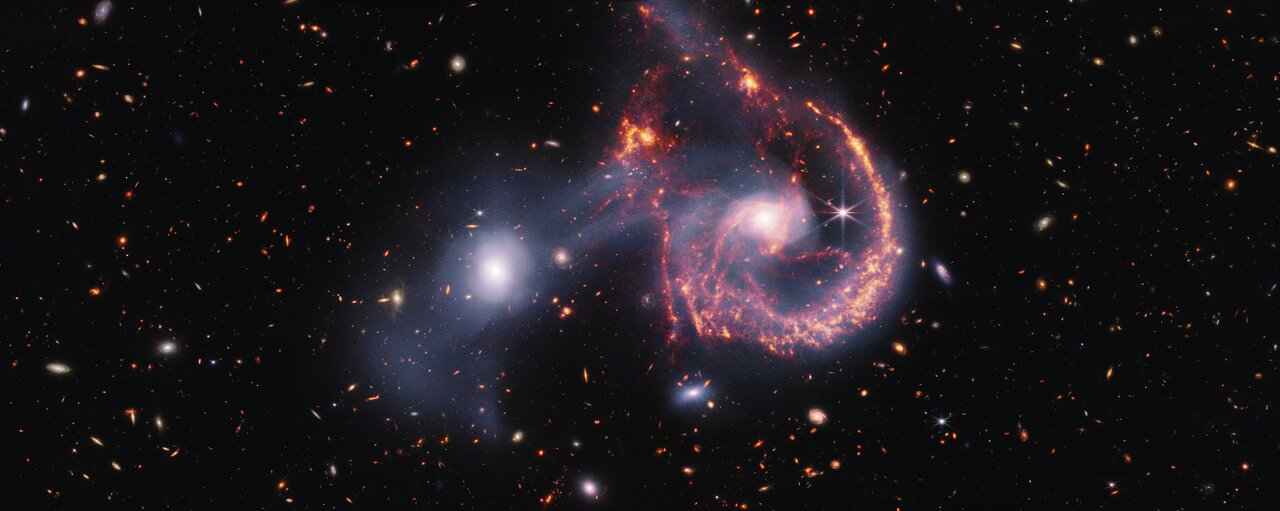About the Object
| Name: | Arp 107 | |
|---|---|---|
| Distance: |
465 million light years | |
| Constellation: | Leo Minor | |
| Category: | Galaxies MIRI NIRCam | |
Coordinates
| Position (RA): | 10 52 16.81 | |
|---|---|---|
| Position (Dec): | 30° 3' 51.10" | |
| Band | Wavelength | Telescope |
|---|---|---|
| Optical | 900 nm | James Webb Space Telescope NIRCam |
| Infrared | 1.5 μm | James Webb Space Telescope NIRCam |
| Infrared | 2.77 μm | James Webb Space Telescope NIRCam |
| Infrared | 2.0 μm | James Webb Space Telescope NIRCam |
|
Infrared
PAH | 7.7 μm | James Webb Space Telescope MIRI |
|
Infrared
Silicate | 10 μm | James Webb Space Telescope MIRI |
| Infrared | 15 μm | James Webb Space Telescope MIRI |
| Infrared | 3.56 μm | James Webb Space Telescope NIRCam |
| Infrared | 4.44 μm | James Webb Space Telescope NIRCam |
Arp 107 composite image (NIRCam + MIRI)
This composite image of Arp 107, created with data from the James Webb Space Telescope’s NIRCam (Near-InfraRed Camera) and MIRI (Mid-InfraRed Instrument), reveals a wealth of information about the star formation taking place in these two galaxies and how they collided hundreds of million years ago.
The near-infrared data, shown in white, show older stars, which shine brightly in both galaxies, as well as the tenuous gas bridge that runs between them. The vibrant background galaxies are also brightly illuminated at these wavelengths.
On the other hand, MIRI data show the young stars and star-forming regions in vibrant orange and red. Our view in the mid-infrared provides the best view of the collision point, given the noticeable gap at the top of the spiral galaxy. This collision not only began a new bout of star formation in the region, but also produced an endearing smile.
[Image description: A pair of interacting galaxies. The larger of the two galaxies is slightly right of centre, and is composed of a hazy, bright, white centre and a ring of gaseous filaments, which are different shades of red and orange. Toward the bottom left and bottom right of the ring are filaments of gas spiralling inward toward the core. At the top left of the ring is a noticeable gap, bordered by two large, orange pockets of dust and gas. The smaller galaxy is made of hazy and white gas and dust, which become more diffuse further away from its centre. To this galaxy’s bottom left, there is a smaller, more diffuse gas cloud that wafts outward toward the edges of the image. Many red, orange, and white galaxies are spread throughout, with some being hazier in appearance and others having more defined spiral patterns.]
Credit:NASA, ESA, CSA, STScI
About the Image
| Id: | weic2423a | |
|---|---|---|
| Type: | Observation | |
| Release date: | 18 September 2024, 16:00 | |
| Related releases: | weic2423 | |
| Size: | 10427 x 4161 px | |


